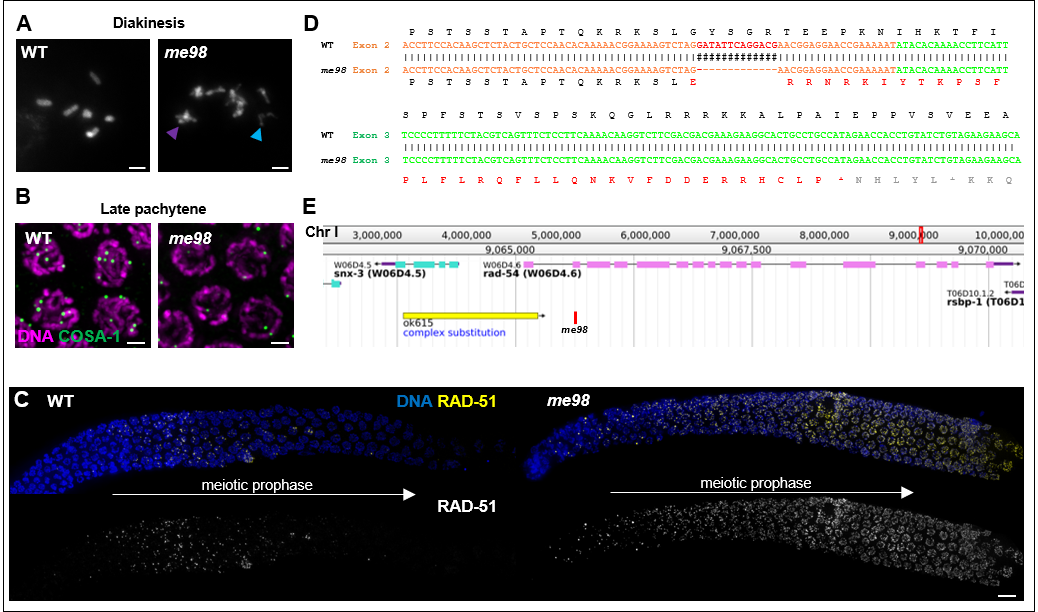Description
We isolated the me98 mutant in a genetic screen for C. elegans mutants with an altered number of GFP::COSA-1 foci, which mark the sites of crossovers in wild-type C. elegans germ cells (Rosu et al. 2013). After multiple rounds of outcrossing, we confirmed that the me98 mutant is defective in meiotic prophase as i) chromosomes in diakinesis oocytes appear partially decondensed and structurally compromised (Fig. 1A), ii) me98 fails to form the six GFP::COSA-1 foci observed in wild-type late pachytene meiocytes (Fig. 1B) and iii) me98 accumulates RAD-51 foci during the course of meiotic prophase (Fig. 1C). Further, 100% of eggs laid by me98 mutant hermaphrodites are inviable. These defects are reminiscent of those caused by the previously-described rad-54(ok615) mutation (Mets and Meyer 2009), and sequencing of the rad-54 locus in me98 mutants revealed the presence of a 13bp deletion in the second exon of the annotated transcript (I:9065652 to I:9065664 of WS269). This lesion creates a frameshift that would result in premature termination of translation in the third exon (of seventeen) of the predicted transcript (Fig. 1D), suggesting that it is likely a null allele. Of note, the previously described rad-54 loss-of-function allele, ok615, is an insertion/deletion that also affects the neighboring gene snx-3 (Fig 1E). As gonads of rad-54(me98) mutants appear overall healthier than those in the ok615 mutant, me98 could be a valuable tool to analyze the specific function of rad-54.
Methods
Request a detailed protocolCytology: Immunofluorescent detection of GFP::COSA-1 and RAD-51 was performed as described in (Martinez-Perez and Villeneuve 2005) using a mouse anti-GFP antibody (Sigma-Aldrich #11814460001) and a rabbit anti-RAD-51 antibody (Colaiacovo et al. 2003).
Reagents
Strains:
AV727: meIs8[pie-1p::gfp::cosa-1 + unc-119(+)] II;ltIs37[pie-1p::mCherry::his-58 + unc-119(+)] IV;ltIs38[pie-1p::gfp::ph(PLC1delta1) + unc-119(+)]
AV762: rad-54(me98)/hT2[qIs48] (I;III);meIs8[pie-1p::gfp::cosa-1 + unc-119(+)] II;ltIs37[pie-1p::mCherry::his-58 + unc-119(+)] IV;ltIs38[pie-1p::gfp::ph(PLC1delta1) + unc-119(+)]
References
Funding
This work was supported by NIH grants R01GM067268 and R35GM126964 to AMV
Reviewed By
Cori CahoonHistory
Received: April 11, 2019Accepted: April 26, 2019
Published: April 26, 2019
Copyright
© 2019 by the authors. This is an open-access article distributed under the terms of the Creative Commons Attribution 4.0 International (CC BY 4.0) License, which permits unrestricted use, distribution, and reproduction in any medium, provided the original author and source are credited.Citation
Roelens, B; Zawadzki, KA; Villeneuve, AM (2019). me98 is a new allele of rad-54. microPublication Biology. 10.17912/micropub.biology.000108.Download: RIS BibTeX




